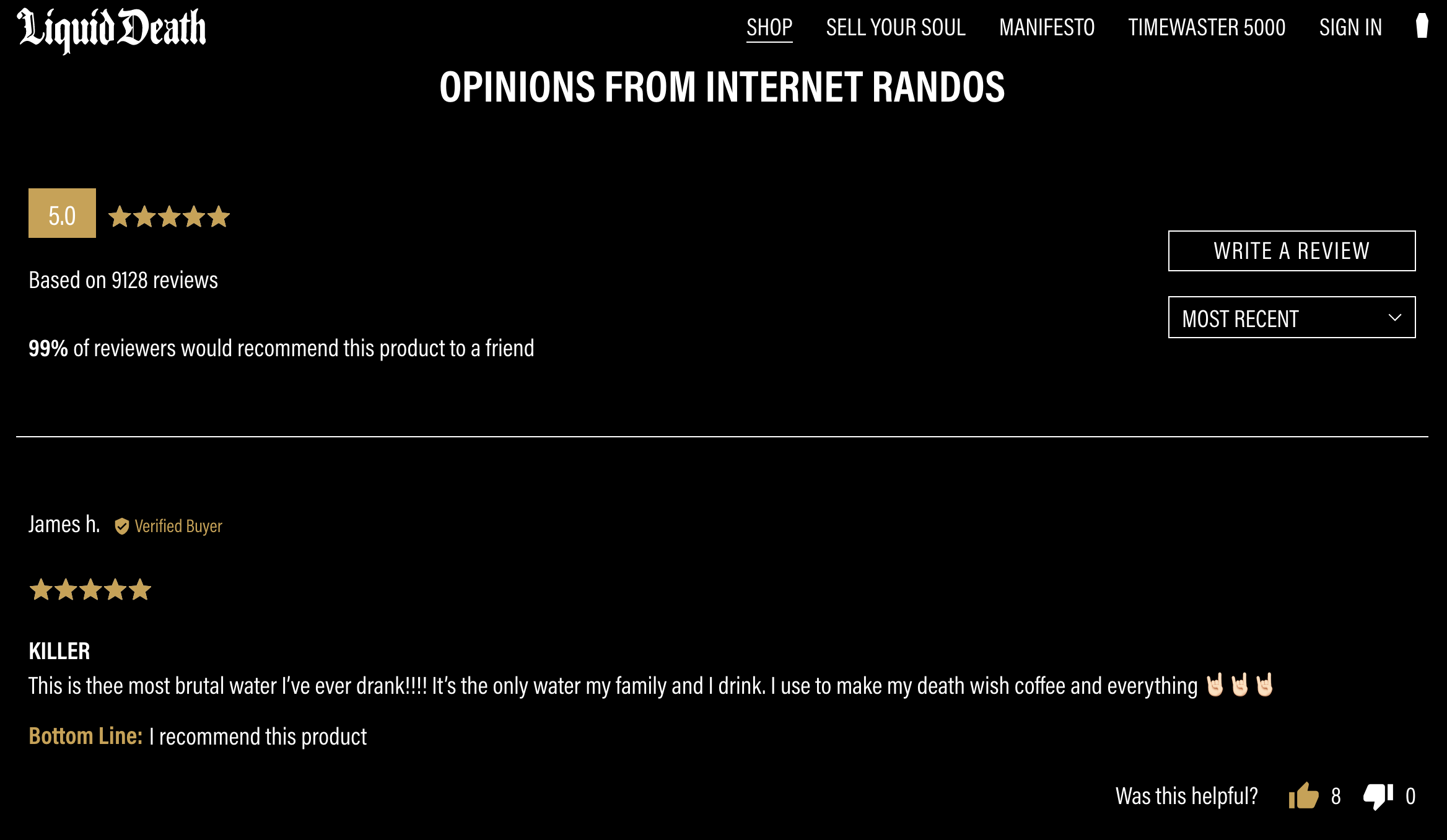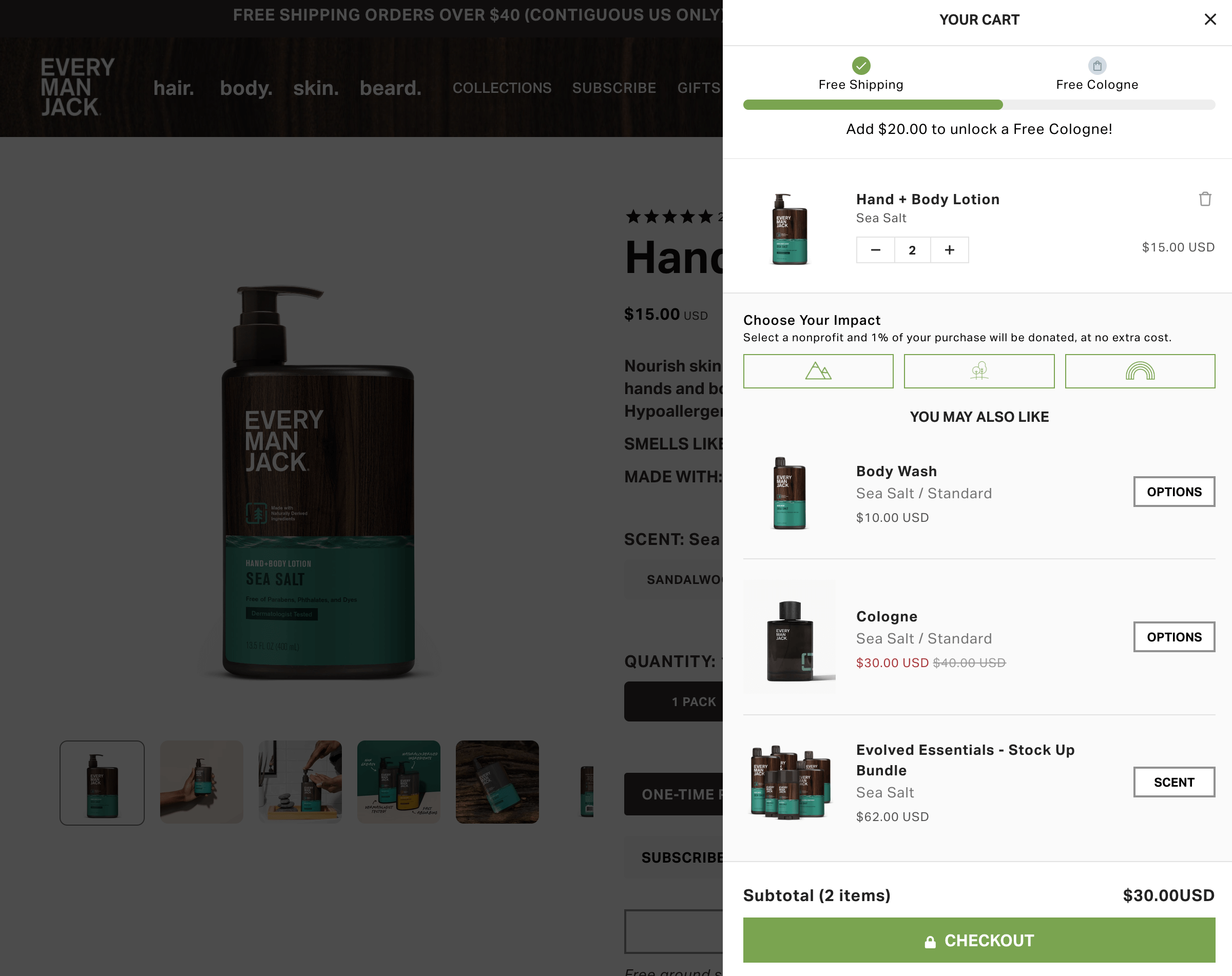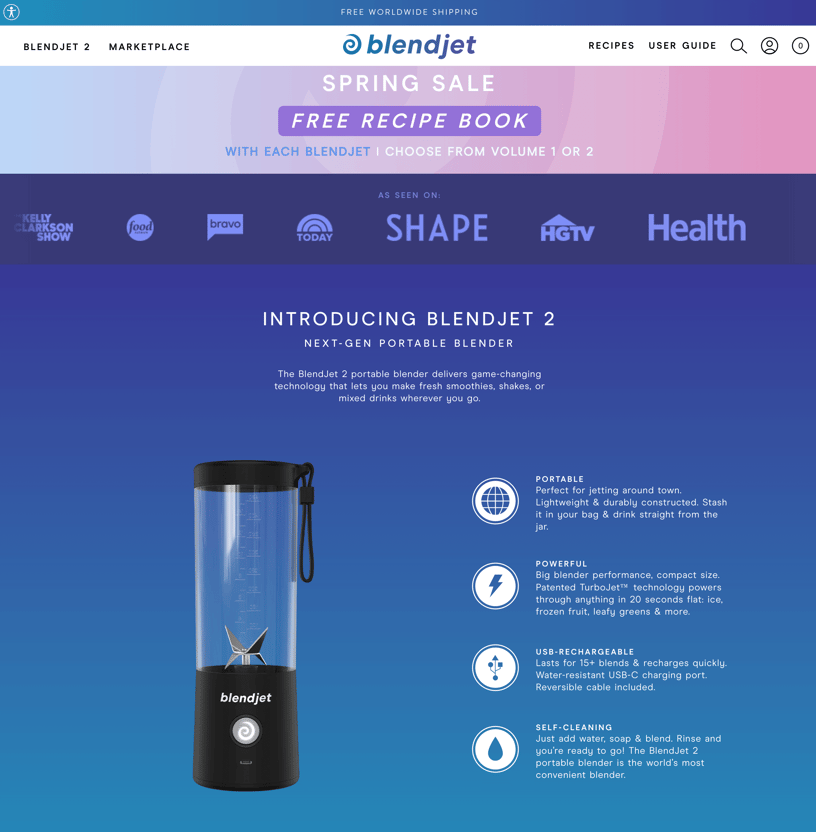Ecommerce Personalization: The Complete Guide for Founders, Merchants, and Marketers
Your ecommerce personalization journey starts here👇

Learn seven proven strategies to boost your store's conversion rate and increase sales through website optimization and an enhanced user experience.
We all love seeing an increase in website traffic to our online stores. But if visitors to your brand aren’t making purchases (meaning your website’s conversion rate is stagnant) then traffic to your store isn’t worth much.
Understanding and improving ecommerce conversion rates is crucial for online retail businesses. It can help turn website visitors into buyers and capitalize on the online browsing habits of consumers.
It’s like having a bunch of customers stroll through the aisles of a brick-and-mortar store, browse all the products, walk past the checkout, and leave without buying anything. Customers who are prone to window shopping don’t help a brand’s bottom line.
So why aren’t customers purchasing? That’s what conversion rate optimization is all about. Focusing on that why and making the necessary tweaks to your website’s customer experience to get them to convert.
In some instances, the value proposition of your products just isn’t moving the needle for customers. For other shoppers, it could be that navigating to product landing pages or checking out is too clunky a user experience and leads to abandoned carts.
So what are some tried and true methods to boost conversions for your store and get your products moving into the hands of highly engaged customers?
Look no further — we’ve put together seven of the best ways for your brand to improve your conversion rate. Let’s dive in.
In ecommerce, conversion rate refers to the percentage of people who visit and subsequently purchase, items from an online store.
So what is a good conversion rate? It’s a little more complicated than that.
Different businesses have different goals so there are many different ways to interpret conversion data to see if you’re hitting your targets. A variety of factors play into this like the size of your business, your product category, seasonality, the marketing strategy you’re implementing, and so on.
This doesn’t have to be a macro statistic as well. Your brand can look more granularly at specific sections of your online store to see about improving your conversion rate on those specific web pages.
For instance, you might be running an ad campaign linked to a specific product landing page that you’re looking to improve your conversion rate on. Or perhaps you’re focusing on improving conversions on a specific email series you’ve been sending to customers.
This process of fine-tuning these web pages to increase your conversions is known as conversion rate optimization (or CRO if you want to save some characters). Think about it like working smarter, not harder to reduce customer pain points and make purchasing from your website a seamless experience for potential customers. This is where conversion optimization comes into play, encompassing strategies like enhancing sales copy, analyzing visitor data, and optimizing the conversion funnel.
So before we get into the seven ways to boost your website conversion rate let’s break down how you go about calculating it.
The formula for finding your conversion rate is straightforward, even if you graduated from high school thinking ‘common core’ was a pilates move:
(# of conversions / total visitors) x 100
For example, let's say your website got 1,500 visits in one day and 20 people bought something from you. That would make the conversion rate (20/1500) x 100 = 1.3%
As of May 2022, “average conversion rates across ecommerce businesses were at 1.78 percent, falling 0.06 percentage points from the previous month and 0.05 percentage points from a year ago,” as reported by Oberlo.
So why does all this matter? A sale is a sale. Shouldn’t that be good enough?
Without calculating your CVR (shorthand for conversion rate), it’s tough to tell which strategies are really working. You also can’t figure out which tactics are a complete waste of time and money, and neither you nor your business can afford to spend too much of one or lose too much of the other. Understanding the behavior of your website visitors is crucial for optimizing these strategies.
So what is an ideal conversion rate? So many factors play into it that we’d suggest a different way of looking at things.
A good ecommerce conversion rate is typically considered to be 3% or higher, and achieving this rate should be your baseline goal before moving on to more advanced conversion rate tactics.
One of the best pieces of advice for setting conversion goals (or really improving any ecommerce metric) is to look internally as opposed to externally.
Beat your best.
Don’t worry about what competitors might tout for their conversion rates or trying to beat some nebulous but ambitious industry benchmark.
Instead of focusing on others, concentrate your time and energy on calculating and monitoring your own conversion rate. Aim to improve it over a particular time frame, like a month or a quarter, and use web analytics tools like Google Analytics to track your visitors. Combine these backend metrics with your conversion data to gauge your performance over time.
Now how exactly can you boost those conversation rates? Let’s break it down.
Have you ever bought an item online without reading at least one review? If so you’re in the very tiny minority: 95% of consumers read online reviews before they shop and 58% say they would pay more for the products of a brand with good reviews.
While most of us like to think of ourselves as unique, we are actually very social creatures that are influenced by the opinions of others. How else could bell bottoms and feathered hair have become so popular?
People tend to have faith in the word of experts or celebrities, so an endorsement by one can boost your brand quite a bit. If you don’t have access to an expert and your celebrity stalking hasn’t resulted in a famous bff yet, you can also employ another form of social proof — add testimonials from your own customers.
While sheer numbers of reviews can and will affect the good opinion of your buyers, adding an extra layer of authenticity will prove to potential customers that your product really is as great as people are saying.
To do this, link your business with social media sites like Instagram and Twitter to get people to like and follow you. Boost your sales even more by offering purchase links through these platforms.
Put all the social proof a customer needs front and center on your site so they don’t have to go hunting for it - this will skyrocket their confidence in your product AND increase your CVR.

Don’t forget, your reviews are a great place to embrace using your brand tone to highlight your reviews like Liquid Death does in the image above when referring to their reviews as “Opinions from internet randos”.
Make sure to position these reviews prominently on your product pages to optimize conversion rates.
We all love a good deal, so tapping into a potential buyer's need to get the most bang for their buck is a win-win. Discounts on bulk orders or package deals are a great way to get a customer to add a few more things to their online cart. If you can, offer free shipping.
The word “free” is a powerful one for both the consumer and the seller. The buyer is more likely to spend more if they feel like they just got some money back in their pocket that they would have otherwise spent on shipping. You can even include a price break for bulk purchases in addition to discounted/free shipping.
You should adjust your free shipping thresholds depending on what's more beneficial to your business. Think of what goals you're trying to achieve and whether it's better to encourage customers to buy more or fewer items, taking into account the amount you're able to spend on shipping costs.
Who doesn't love a free item?
Costco regularly draws people and increases sales of selected items with free samples and Clinique customers barely noticed that their favorite concealer increased in price when it was connected to the magic words “gift with purchase.”
People love free items even more than discounted ones. Let shoppers know right away what awaits them at the other end of the checkout process if they make a purchase or spend a minimum amount.
On your website, you can make it easy for customers to let them know how close they are to getting the offer, like a progress bar or pop-up. For example, it could say something like "You don't have much more to go - another $4 for your free gift!" Engines like Rebuy display just such a bar — a classic CRO tactic our friends at Every Man Jack currently implements very successfully.

There are a few things to keep in mind when deciding whether to do a free gift promotion.
It's essential to offer something that customers will find appealing. Make sure the product you choose is a good match for your brand and visually pops when customers land on your homepage. You want buyers to be intrigued by the offer before they even start scrolling.
Check that you have enough stock of your freebie to cope with the extra orders. One of the fastest ways to lose customers is to not deliver on your promises.
Factor in possible shipping costs. A tiny item won't have a significant impact, but a bigger item might increase both your packaging and shipping budget.
We humans have a genuine fear of missing out (FOMO - just saved you another 1/10 of a second), whether it be an experience or a product.
By gently nudging your customers toward making a purchase they might not otherwise have made, you are not only providing a quality product to the world, but also a service to all of online shopping humanity. None of YOUR buyers will go to bed with regrets. Why? Because you teamed up to get them the right products at the right price at the right time.
Holiday deals are an ideal and proven time of increased sales, but also think outside the box a bit and consider those poor procrastinators that don't do their shopping on Black Friday, or eagerly wait for the after-Christmas sales.
Many sites now offer longer Black Friday and Cyber Monday deals to attract more shoppers. This is ideal for those who want to take their time deciding before purchasing or have to wait for a paycheque to come through.

Run your own sales, like BlendJet is doing above with their Spring Sale Deals, or run a limited supply of products to create that sense of scarcity or monetary benefit and encourage shoppers to purchase.
It’s no secret that shopping online can be a tricky game and a clearly secure site is more likely to get new and existing customers to keep choosing you. How do you show them that you have their back? Companies need to make sure their customers’ data is securely stored and protected from malicious users. Showing buyers that their information is being dealt with respectfully and responsibly provides them with peace of mind.
Auditing and fixing broken links is crucial to maintain user trust and ensure a smooth user experience.
There are several things you can integrate into your online shop to reassure your buyers that security measures are in place to protect their data.
Some of these include:
Displaying relevant security badges from well-known brands like Norton or McAfee
Offering multiple payment options, so the buyer can choose the one they feel is safest for them.
Providing clear and concise explanations for returns or exchanges and how and when money will be refunded.

All of the trust signals in the world won’t convince everyone to create an account the first time they buy from a new store. Offering a guest checkout option can lower conversion rates by minimizing the hurdles shoppers have to jump through to make a purchase.
And let’s also be honest, we all know that the minute you put your personal data into a site, there is a fair to middlin’ chance that it is going to come back to haunt you in the form of stolen identity or credit card details.
Or you might have your email sold, only to live on a list somewhere that will forward you junk mail until you either suffer a psychotic break or go off the grid.
Being forced to create an account also might tip some buyers on the fence about actually wanting the product at all to the wrong side and you’ll lose them. So, help out that poor worker on their 15-minute break that came across your product and wants it ordered and paid for before he has to clock back in and finish his shift.
Once you follow the experience up with a great product, fast shipping, and a simple return policy and you are on your way to having a customer for life.
Mobile ecommerce sales are expected to surpass $430 billion in 2022, yet almost 90% of people say the actual experience of shopping on mobile devices could be better. Give the people what they want and optimize for mobile. Consider how people navigate your site and check out and how that can better translate to the mobile online buying experience.
.png?width=816&height=1625&name=IMG_8069%20(1).png)
Avoiding a complicated checkout process on mobile devices is crucial to ensure a smooth and efficient purchasing experience.
The goal of mobile optimization is to make sure your site is as navigable and attractive on a mobile screen as it is on a larger one like our friends at Chamberlain Coffee did here.
Creating a website that offers an optimal experience regardless of the type of screen it is viewed is paramount to increasing mobile conversion rates.
You didn’t think we were done offering advice, did you? Adding Rebuy to your online shop is one of the best ways to strengthen your conversion rate optimization by analyzing site visitors.
Understanding and communicating with your target audience is crucial to improving conversion rates. Tailor your content to address their goals and pain points, and convey a value proposition that resonates with them.
Rebuy offers smart product recommendations through seamless upsells and cross-sells which is a tried and true method of getting more conversions. Personalize your customers’ experience by recommending products that make sense for them. For instance, someone buying running shoes might be nudged toward buying a certain type of sock that is also ideal for running.
Bonus: this move can increase your AOV too.
Your ecommerce personalization journey starts here👇
Using Rebuy’s Smart Links feature to connect the buying experience, optimize marketing campaigns, and shorten time-to-sale with pre-filled, pre-configured links and landing pages.
Email marketing integrations are another key move to boost your conversion rates. Rebuy integrates with Klaviyo so users can easily reach out to new shoppers, current customers, and those you haven’t seen in a while but know just the product that could bring them back.
With its intuitive design, Rebuy’s subtle but powerful CRO tactics fit seamlessly into your online shop’s distinctly branded display. Learn how using Rebuy can help to improve conversion rates and other KPIs by scheduling a demo today.
What do you have to lose (besides the chance for more customers and increased sales?)
•••
Try Rebuy free and see why the world’s top brands use Rebuy to accelerate sales growth.
Interested in partnering with Rebuy? Let's do it.
To keep up with the latest trends, updates, and more, follow us on LinkedIn.
Ecommerce personalization has arrived and it's coming to an online store near you. Learn why personalization is critical to your brand's success.
Learn how to create memorable post-purchase experiences for your ecommerce store and why doing so is good for business. Perfect for Shopify.
Transform your online store with visual merchandising: Engage customers and create an immersive shopping experience that makes an impression.
Stay up to date with all things Rebuy by signing up for our newsletter.
